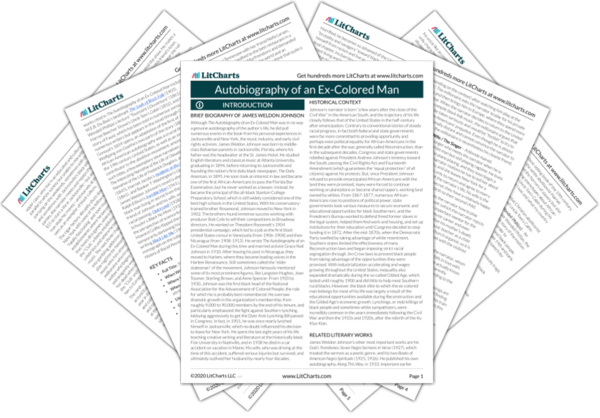Welcome to the LitCharts study guide on James Weldon Johnson's Autobiography of an Ex-Colored Man. Created by the original team behind SparkNotes, LitCharts are the world's best literature guides.
Autobiography of an Ex-Colored Man: Introduction
Autobiography of an Ex-Colored Man: Plot Summary
Autobiography of an Ex-Colored Man: Detailed Summary & Analysis
Autobiography of an Ex-Colored Man: Themes
Autobiography of an Ex-Colored Man: Quotes
Autobiography of an Ex-Colored Man: Characters
Autobiography of an Ex-Colored Man: Terms
Autobiography of an Ex-Colored Man: Symbols
Autobiography of an Ex-Colored Man: Literary Devices
Autobiography of an Ex-Colored Man: Theme Wheel
Brief Biography of James Weldon Johnson

Historical Context of Autobiography of an Ex-Colored Man
Other Books Related to Autobiography of an Ex-Colored Man
- Full Title: The Autobiography of an Ex-Colored Man
- When Written: 1906-12
- Where Written: New York City, Venezuela, Nicaragua
- When Published: 1912 (anonymously), 1927 (with attribution)
- Literary Period: Modernism, Harlem Renaissance
- Genre: Novel, African-American Autobiography
- Setting: The Eastern Seaboard of the United States (primarily Georgia, Connecticut, Florida, and New York) and European cities (Paris, London, Amsterdam, and Berlin) from roughly the 1870s through the 1910s.
- Climax: The narrator witnesses a lynching in Georgia and resolves to “change my name, raise a mustache, and let the world take me for what it would.”
- Antagonist: American racism, moral cowardice, shame
- Point of View: First-person
Extra Credit for Autobiography of an Ex-Colored Man
“Passing” in Tennessee. Although James Weldon Johnson could never pass as white, his wife Grace Nail Johnson once did, on a trip to rural Tennessee with her friend Nella Larsen, who later wrote that they “walked to the best restaurant in a rather conservative town called Murfreesboro and demanded lunch and got it, plus all the service in the world and an invitation to return. Everybody here seems to think that quite a stunt.”
Black National Anthem. James Weldon Johnson and his brother Rosamond wrote the song “Lift Every Voice and Sing” for a 1900 memorial service for Abraham Lincoln. The immensely popular song has since become a staple in black politics and come to be known as the “Black National Anthem.”







